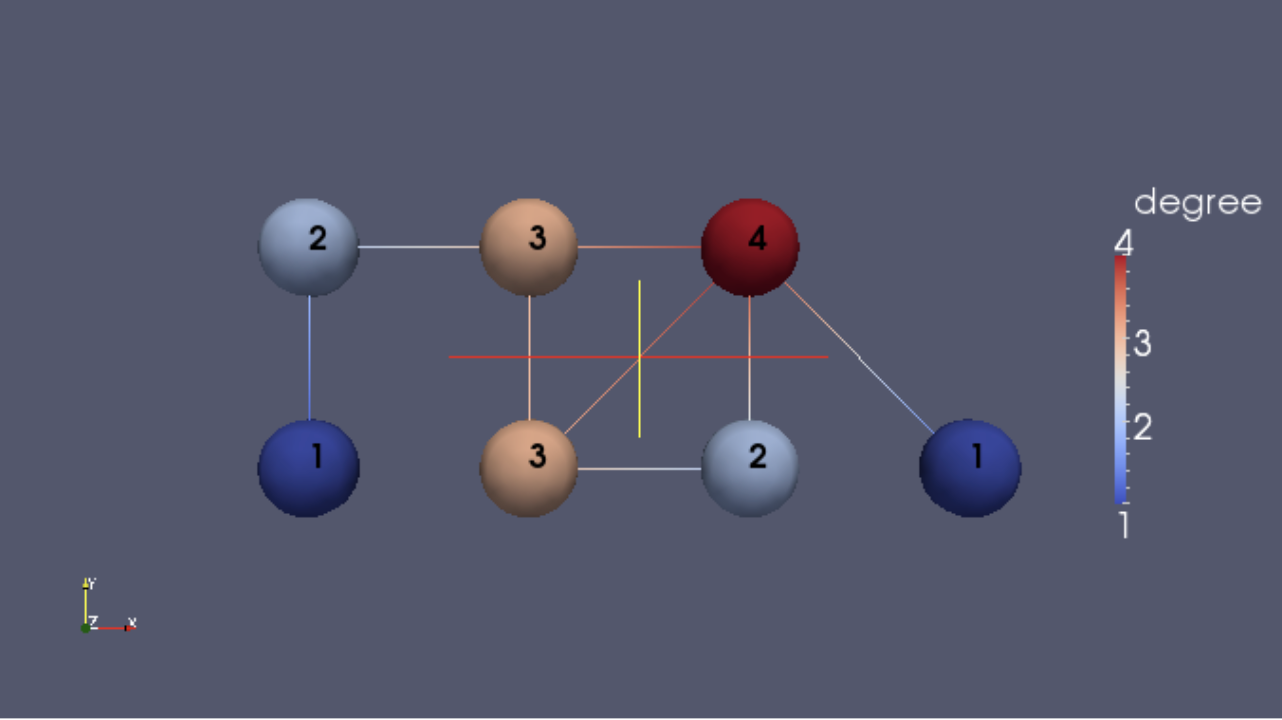NOVCAGraph
Repository source: NOVCAGraph
Description¶

-
This example shows how to construct a graph to visualize it in ParaView/VisIt using the VTK output file testVertex.vtu.
-
Contributed by Sanjaya Gajurel, Case Western Reserve University
Other languages
See (Cxx)
Question
If you have a question about this example, please use the VTK Discourse Forum
Code¶
NOVCAGraph.py
#!/usr/bin/env python
# noinspection PyUnresolvedReferences
import vtkmodules.vtkInteractionStyle
# noinspection PyUnresolvedReferences
import vtkmodules.vtkRenderingOpenGL2
from vtkmodules.vtkCommonCore import (
vtkIntArray,
vtkPoints
)
from vtkmodules.vtkCommonDataModel import (
VTK_LINE,
vtkCellArray,
vtkUnstructuredGrid
)
from vtkmodules.vtkFiltersSources import vtkPointSource
from vtkmodules.vtkIOXML import vtkXMLUnstructuredGridWriter
def get_program_parameters():
import argparse
description = 'Building a graph using Unstructured Grid & dumping it into a vtk file.'
epilogue = '''
Building a graph using Unstructured Grid & dumping it into a vtk file, to be visualized using ParaView.
The generated file can then be used in ParaView/VisIt.
'''
parser = argparse.ArgumentParser(description=description, epilog=epilogue)
parser.add_argument('filename', help='A required vtk filename, e.g. vertex.vtu.', nargs='?', const='vertex.vtu',
type=str, default='testVertex.vtu')
args = parser.parse_args()
return args.filename
def main():
fn = get_program_parameters()
pointSource = vtkPointSource()
pointSource.Update()
# Create an integer array to store vertex id data & link it with its degree value as a scalar.
degree = vtkIntArray()
degree.SetNumberOfComponents(1)
degree.SetName('degree')
degree.SetNumberOfTuples(7)
degree.SetValue(0, 2)
degree.SetValue(1, 1)
degree.SetValue(2, 3)
degree.SetValue(3, 3)
degree.SetValue(4, 4)
degree.SetValue(5, 2)
degree.SetValue(6, 1)
pointSource.GetOutput().GetPointData().AddArray(degree)
# Assign co-ordinates for vertices
Points = vtkPoints()
Points.InsertNextPoint(0, 1, 0)
Points.InsertNextPoint(0, 0, 0)
Points.InsertNextPoint(1, 1, 0)
Points.InsertNextPoint(1, 0, 0)
Points.InsertNextPoint(2, 1, 0)
Points.InsertNextPoint(2, 0, 0)
Points.InsertNextPoint(3, 0, 0)
# Establish the specified edges using CellArray
line = vtkCellArray()
line.Allocate(8)
line.InsertNextCell(2)
line.InsertCellPoint(0)
line.InsertCellPoint(1)
line.InsertNextCell(2)
line.InsertCellPoint(0)
line.InsertCellPoint(2)
line.InsertNextCell(2)
line.InsertCellPoint(2)
line.InsertCellPoint(3)
line.InsertNextCell(2)
line.InsertCellPoint(2)
line.InsertCellPoint(4)
line.InsertNextCell(2)
line.InsertCellPoint(3)
line.InsertCellPoint(4)
line.InsertNextCell(2)
line.InsertCellPoint(3)
line.InsertCellPoint(5)
line.InsertNextCell(2)
line.InsertCellPoint(4)
line.InsertCellPoint(5)
line.InsertNextCell(2)
line.InsertCellPoint(4)
line.InsertCellPoint(6)
# Add the vertices and edges to unstructured Grid
G = vtkUnstructuredGrid()
G.GetPointData().SetScalars(degree)
G.SetPoints(Points)
G.SetCells(VTK_LINE, line)
# Dump the graph in VTK unstructured format (.vtu)
gw = vtkXMLUnstructuredGridWriter()
gw.SetFileName(fn)
gw.SetInputData(G)
gw.Write()
print('---> ')
print('Feed the vertex.vtu file in ParaView/VisIt.')
if __name__ == '__main__':
main()